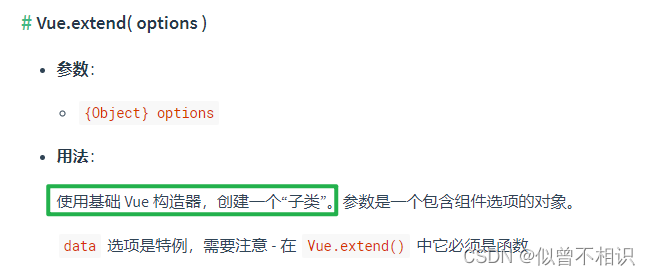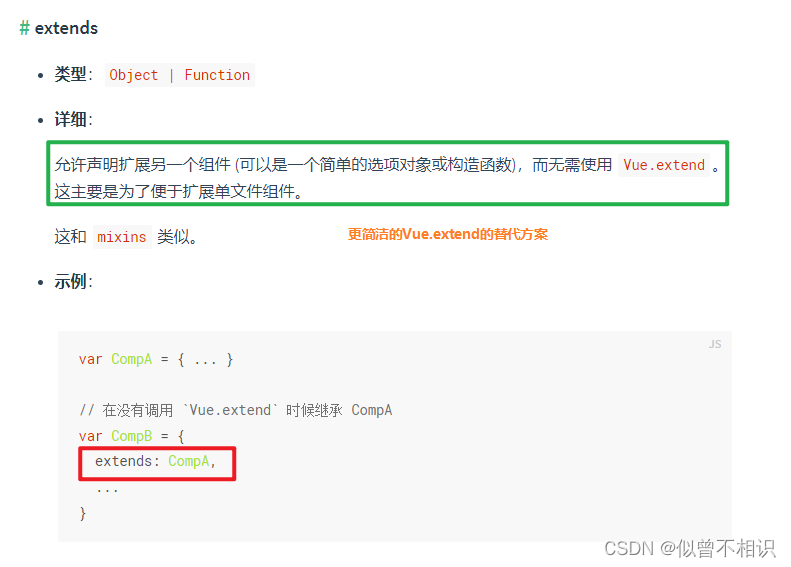如何建设自己的企业网站免费个人推广引流平台
提到extends继承,最先想到的可能是ES6中的class、TS中的interface、面向对象编程语言中中的类和接口概念等等,但是我们今天的关注点在于:如何在Vue中使用extends继承特性。
目录
Vue:创建Vue实例的方式
构造函数方式:new Vue
Vue.extend方式
Vue.component方式
render渲染函数方式
对象方式
Vue:extends继承特性
Vue:创建Vue实例的方式
再开始探讨Vue继承相关的内容之前,有必要回顾一下创建Vue组件实例的几种方式,个人总结如下,
构造函数方式:new Vue
这种方式是较为常见的,在Vue-cli脚手架构建的前端项目中,经常看到如下所示的代码段,
new Vue({router,store,render: h => h(App)
}).$mount('#app')这就是在以Vue构造函数的方式创建实例,然后将其挂载到id选择器为app的DOM元素上。
Vue.extend方式
Vue.js开发库提供了Vue.extend()API,用于创建一个组件。

Vue.extend()方法的源码如下,内部主要是创建了一个Vue组件对象,并通过外部配置项,将其props、computed、mixin等选项设置为可用,最终将对象返回,
/*** Class inheritance*/Vue.extend = function (extendOptions) {extendOptions = extendOptions || {};//外部配置项-即:Vue组件的选项配置console.log(extendOptions)var Super = this;//指向Vue自身实例的引用var SuperId = Super.cid;var cachedCtors = extendOptions._Ctor || (extendOptions._Ctor = {});if (cachedCtors[SuperId]) {return cachedCtors[SuperId];}var name = getComponentName(extendOptions) || getComponentName(Super.options);if (name) {validateComponentName(name);}var Sub = function VueComponent(options) {this._init(options);};Sub.prototype = Object.create(Super.prototype);Sub.prototype.constructor = Sub;Sub.cid = cid++;Sub.options = mergeOptions(Super.options, extendOptions);Sub['super'] = Super;// For props and computed properties, we define the proxy getters on// the Vue instances at extension time, on the extended prototype. This// avoids Object.defineProperty calls for each instance created.if (Sub.options.props) {initProps(Sub);}if (Sub.options.computed) {initComputed(Sub);}// allow further extension/mixin/plugin usageSub.extend = Super.extend;Sub.mixin = Super.mixin;Sub.use = Super.use;// create asset registers, so extended classes// can have their private assets too.ASSET_TYPES.forEach(function (type) {Sub[type] = Super[type];});// enable recursive self-lookupif (name) {Sub.options.components[name] = Sub;}// keep a reference to the super options at extension time.// later at instantiation we can check if Super's options have// been updated.Sub.superOptions = Super.options;Sub.extendOptions = extendOptions;Sub.sealedOptions = extend({}, Sub.options);// cache constructorcachedCtors[SuperId] = Sub;return Sub;}通过查看Vue.extend()方法的源码,我们会发现,它内部是在调用Vue原型对象上面的_init()方法来完成组件初始化,通过如下图所示的一些核心配置,使其成为一个名副其实的Vue组件实例,

那么我们自己如何调用Vue.extend()方法创建组件呢?示例代码如下,
/*** 方式1-Vue.extend-使用基础 Vue 构造器,创建一个组件* PS:此种方式中,data必须为函数* */const IButton = Vue.extend({name: "IButton",template: `<button class="btn" @click="clickBtnHandler($event)">Click</button>`,methods: {clickBtnHandler(e) {console.log(e.target.dataset)}},})Vue.component('i-button', IButton);//Vue.component用途之一:将组件注册到全局环境Vue.component方式

Vue.component()方法有两个作用,其①:将组件注册全局可用的组件;其②:以给定的id,创建一个全局范围内可用的组件。使用此接口创建一个Vue组件的示例代码如下,
/*** 方式2-Vue.component-间接调用Vue.extend,创建一个组件* PS:此种方式中,data必须为函数* */const IList = Vue.component('i-list', {template: `<div><p>列表</p><ul><li v-for="n in number">{{n}}</li></ul></div>`,data: function () {return {number: 5}}})// Vue.component('i-list', IList);//Vue.component创建的组件无需再注册render渲染函数方式

也可以通过Vue.js提供的render()渲染函数创建一个Vue组件,如下示例代码,通过render函数的函数,根据props参数level来创建了一个级别为level的h标签,并提供插槽供开发者对其进行拓展。
//方式3:基于渲染函数构造函数式组件-[基于slot插槽方式提供组件内容1]const ITitle = Vue.component("i-title",{render: function (createElement) {return createElement('h' + this.level, // 标签名称this.$slots.default // 子节点数组)},props: {level: {type: Number,required: true}}});对象方式

通过对象的形式定义组件-这也是我们在Vue前端应用开发中最常使用的方式,然后通过export default导出。示例代码如下,
//方式4-通过对象的形式定义组件-这也是我们在Vue前端应用开发中最常使用的方式,然后通过export default导出const InfoBox = {name: "InfoBox",template: `<div class="box" :style="styleObject">{{content}}</div>`,data() {return {content: '消息内容',styleObject: {boxSizing: "border-box",padding: "25px",width: '300px',height: '200px',backgroundColor: 'rgba(0,0,0,0.3)'}}}}Vue.component('info-box', InfoBox);//Vue.component用途之一:将组件注册到全局环境Vue:extends继承特性
第一部分只介绍了如何创建一个组件,并没有介绍如何去提高一个组件的复用性。既然谈到复用性,可行的方法有很多,例如:slot插槽、mixix混入、Vue.directive自定义一个可复用的指令、通过Install方法开发一个可复用的插件、通过Vue.filter定义一个可复用的过滤器等。关于如上内容,Vue官网都有详细的介绍。
而接下来要讨论的就是Vue官网里面介绍比较含蓄的一种方法:借助extends实现组件的继承。

那么具体如何操作呢?我们先来定义一个基础列表组件IList,并以事件委托的方式为每一个列表元素注册点击事件,示例代码如下,
<!--* @Description: IList列表组件,基于事件委托机制对列表事件回调做了优化处理* @Author: Xwd* @Date: 2023-02-16 00:21:49* @LastEditors: Xwd* @LastEditTime: 2023-02-19 17:03:25* @Attention: 此列表组件的clickHandler()点击事件默认基于index下标来选择性的返回item的值,在一些场景下存在风险-->
<template><div class="i-list"><p v-if="!!title" class="i-title">{{ title }}</p><!-- <div class="split-horizon"></div> --><div v-if="(list || []).length > 0" class="i-content" @click="clickHandler($event)"><div class="i-item" v-for="(item, index) in list" :key="index"><img class="i-item-icon" :src="item.image || noImage" /><div class="i-item-body"><div class="i-item-title">{{ item.title }}<span class="iconfont" title="地图定位" :data-id="item.id":data-index="index"></span></div><div class="i-item-desc" :title="item.desc">{{ item.desc }}</div></div></div></div></div>
</template>
<script>
import noImage from '@/assets/images/no.png';
export default {name: "IList",props: {title: {type: String,required: false,default: "",},list: {type: Array,required: false,default: () => [],}},mounted() { },methods: {/*** 列表元素点击事件-回调函数* @param {*} event */clickHandler(event) {const index = event.target.dataset.index;if (typeof index !== "undefined" && index !== null) {this.$emit("click", this.list[Number(index)], Number(index));}}}
}
</script>
<style lang="less" scoped></style>而由于我们存在一些不确定因素,例如:props中的list是否具有唯一id、点击回调函数中的具体逻辑是什么?所以我们可以将次组件作为一个基组件,在后续使用过程中,在子组件TownList.vue中通过extends的选项,来继承IList组件,实现复用。示例代码如下,
<!--* @Description: * @Author: Xwd* @Date: 2023-02-19 16:50:16* @LastEditors: Xwd* @LastEditTime: 2023-02-19 16:56:57
-->
<script>
import IList from '@/components/layout/IList.vue';
export default {name:"TownList",extends:IList,methods:{/*** 列表元素点击事件-回调函数,覆写父组件方法,基于元素id值重定义处理逻辑* @param {*} event 事件对象*/clickHandler(event) {const id = event.target.dataset.id;console.log(`id=${id}`)if (typeof id !== "undefined" && id !== null) {const dataIndex = this.list.findIndex(item => item.id == id);dataIndex !== -1 & this.$emit("click", this.list[dataIndex], dataIndex)}}}
}
</script>此处我们通过id来区分每一个元素,并覆写了父组件中的clickHandler——点击事件回调方法。最终效果如下,

此种方式的不足之处在于:无法在子组件中添加template节点,否则会直接覆盖掉原有的template模板。
